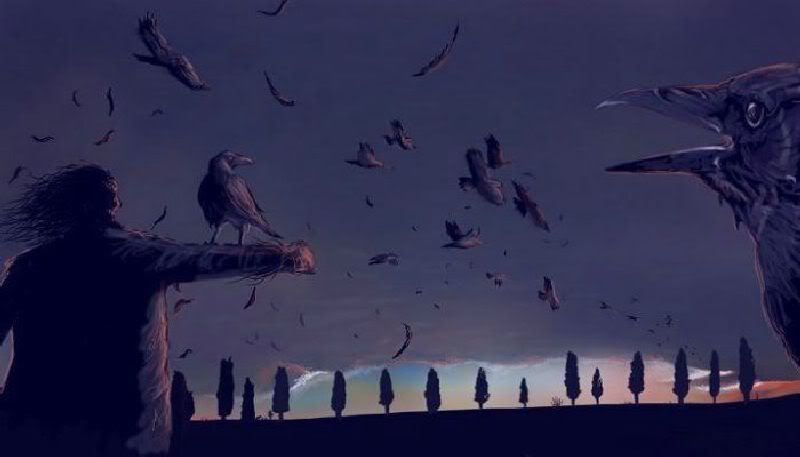(2) Their Intelligence
.
Birds don't have an elaborate cerebral cortex, therefore their day-to-day functioning was believed to be strictly based on their genetic programming, making them almost robotic in nature. However, in the 1960's, neurologist Stanley Cobb found that the avian brain is all together unique system. Rather than a cortex to provide intelligence as the case is with mammals, he found that birds have developed a part in the forebrain called the hyperstraiatum to perform synonymous functions. Crows, ravens, and magpies appear to have the largest hyperstriatums, as well as the largest overall brain size among birds. Moreover, these corvids have brains that contain an exceptionally large number of brain cells. From "Bird Brains," by Candace Savage, she writes: "Crows, ravens, magpies and jays are not just feathered machines, rigidly programmed by their genetics. Instead, they are beings that, within the constraints of their molecular inheritance, make complex decisions and show every sign of enjoying a rich awareness."
Crow enthusiast L.Kilham says that crows and ravens exhibit a decision making ability, citing the following example: A male crow is eating his food in front of a man. Is the crow going to do as usual by going to the nest to feed the female? No, possibly afraid to alert the man of the nest location, he decides to hide the food under some tuft of grass to attain later when it is safe.
Additionally, ravens may have the innate ability to cogitate object numbers--count in a sense. German ethnologist, Otto Koehler, tested this theory by presenting a raven with a group of objects, ranging from two to six in composition. Beside the group of objects were a set of five boxes, each labeled by black dots, two to six. The raven's job was to match the number of objects with the number of black dots on the lid of the box, whereupon a food reward would be relinquished. Apparently, in trial after trial, the raven successfully accoplished the counting task.
Moreover, crow and raven intelligence is evident by their seemingly mastery and manipulative powers over other creatures in their domain. They often let others do the work for them. Ravens will call wolves and coyotes to prospective food sources so they can open up the carcass, making the meat accessible to the birds. And often, they will wait for birds with specialized foraging skills to make a catch (e.g. blue heron and crane), then cunningly, utilizing cooperative tactics, seize the catch for themselves.
.
Birds don't have an elaborate cerebral cortex, therefore their day-to-day functioning was believed to be strictly based on their genetic programming, making them almost robotic in nature. However, in the 1960's, neurologist Stanley Cobb found that the avian brain is all together unique system. Rather than a cortex to provide intelligence as the case is with mammals, he found that birds have developed a part in the forebrain called the hyperstraiatum to perform synonymous functions. Crows, ravens, and magpies appear to have the largest hyperstriatums, as well as the largest overall brain size among birds. Moreover, these corvids have brains that contain an exceptionally large number of brain cells. From "Bird Brains," by Candace Savage, she writes: "Crows, ravens, magpies and jays are not just feathered machines, rigidly programmed by their genetics. Instead, they are beings that, within the constraints of their molecular inheritance, make complex decisions and show every sign of enjoying a rich awareness."
Crow enthusiast L.Kilham says that crows and ravens exhibit a decision making ability, citing the following example: A male crow is eating his food in front of a man. Is the crow going to do as usual by going to the nest to feed the female? No, possibly afraid to alert the man of the nest location, he decides to hide the food under some tuft of grass to attain later when it is safe.
Additionally, ravens may have the innate ability to cogitate object numbers--count in a sense. German ethnologist, Otto Koehler, tested this theory by presenting a raven with a group of objects, ranging from two to six in composition. Beside the group of objects were a set of five boxes, each labeled by black dots, two to six. The raven's job was to match the number of objects with the number of black dots on the lid of the box, whereupon a food reward would be relinquished. Apparently, in trial after trial, the raven successfully accoplished the counting task.
Moreover, crow and raven intelligence is evident by their seemingly mastery and manipulative powers over other creatures in their domain. They often let others do the work for them. Ravens will call wolves and coyotes to prospective food sources so they can open up the carcass, making the meat accessible to the birds. And often, they will wait for birds with specialized foraging skills to make a catch (e.g. blue heron and crane), then cunningly, utilizing cooperative tactics, seize the catch for themselves.
.

![[Go to Site Index]](http://i6.photobucket.com/albums/y225/Abramelinn/Banner_Crow4.jpg)

<< Home